Eyeglasses are devices consisting of glass or hard plastic lenses mounted in a frame that holds them in front of a person’s eyes, typically using a bridge over the nose and arms which rest over the ears. Glasses are typically used for vision correction.

image source: https://en.wikipedia.org/wiki/Glasses#/media/File:Scissors_glasses.jpg
Who invented eyeglasses?

image source: https://en.wikipedia.org/wiki/Glasses#/media/File:Szem%C3%BCveg_-_1920-as_%C3%A9vek.JPG
It is believed that the invention of eyeglasses took place between 1268 and 1289 in Italy. The first eyeglasses had natural crystal lenses and were held in hand because they were too heavy to wear. The vision with these eyeglasses may still be blurry as the natural crystal could not be made uniform. Instead, glasses lenses were lighter to wear, but had bent the light at slightly different angles, so the viewer saw a blurry rainbow around the edges of things, a phenomenon known as “chromatic aberration.” The problem was solved in 1730 by Chester More Hall who used two glass lenses together, one made of “old crown glass” and the other of a newer “flint glass,” to correct the problem. The achromatic lens was a huge step forward leading to strong demand for eyewear from the mid-1700s onwards.
How were glasses made during the Middle Ages?
As James B. Tschen-Emmons notes in Artifacts from Medieval Europe¸ “Bone, wood, or metal were used for frames at first, but in time wire and leather might also house the lenses”.
Over time, the glassmakers became so skilled and knowledgeable about their product that the Duke of Milan ordered 200 pairs in 1466, all of varying strengths. The Duke requested that the strength of the lenses increase based on the ocular degeneration of an average person aged thirty to seventy at five-year intervals so that he had a new, stronger pair to wear every five years. This suggests that enough glasses were being produced for glassmakers to calculate averages such as lens strength based on age, which is pretty impressive. While it was probably difficult for the lowest classes to buy glasses –the duke was still generous enough to buy glasses even for young people with vision problems – they had to be affordable enough to be as ubiquitous as they seem to have been. The variety of materials from which the glasses could be made would help make them widely accessible, and stylish. Many wore glasses for the sake of fashion.

Image source: https://search.creativecommons.org/photos/cb28f3fe-8cd2-4092-9fe3-a47dd780023a by maha-online
What is the History of Eyeglasses?

image source: https://search.creativecommons.org/photos/939d1234-ab63-4705-8f3e-7bd7aa51dd9b by Uncle Catherine
The inventor of the first image magnification technology, developed between the years 1000 and 1250, noted that convex-shaped glass could magnify. These early magnifying glasses served as a precursor to eyeglasses that appeared for the first time in Italy, around the year 1286. They consisted of two framed glass or crystal stones and were brought to the eyes using a handle. Their use soon spread throughout Europe.
During this period, Venice was a Mecca for medieval glass production. The guild of crystal workers was founded in 1284 and 1300, they adopted regulations for the manufacture of “eyes discs”. At the end of the 14th century, thousands of eyeglasses were exported all over Europe.
In the mid-1400s, Florence, Italy became a leader in the production, sale, and innovation of eyeglasses. Glassmakers in the area began creating eyeglasses in various strengths for hyperopes, presbyopes, and myopes. After realizing that vision decreases slowly with age, a complex rating system was implemented, the eyeglasses were rated with progressing strengths for every five years of age.

image source: https://en.wikipedia.org/wiki/Corrective_lens#/media/File:Lens2.png
During the 15th century, eyeglasses were in great demand. Demand increased significantly after the first newspaper, The London Press, appeared in 1665. Possession of eyeglasses became an indication of intelligence, status, and wealth, a view shared by people from Europe, China, Italy, and Spain.
Germany became a major player in eyewear history during the 17th century. The best frames were produced here, although the Italians still produced very high-quality lenses. During this period, eyeglasses also became more widely used in the United States. The first optical shop was founded in Philadelphia in 1799 by John McAllister, Sr.
Before the War of 1812, McAllister imported all the eyeglasses sold in his optical shop. Due to the trade embargo with Britain, he began manufacturing his eyeglass frames in 1815. He and his son John McAllister, Jr., distributed the first astigmatism lenses in the United States. In 1828, they began importing cylindrical lenses to correct astigmatism.
There were over 300 eyeglass retailers in the United States during the 1820s and 1830s. In light of McAllisters’ success, eyeglass manufacturing developed rapidly and companies have diversified their product lines to have telescopes, binoculars, and microscopes.
In the early 20th century, eyeglass manufacturers began to emphasize style and function. The improved plastics used to make the frames in the early 1900s presented a new style of frame. By the 1950s, eyeglasses had become a popular fashion accessory in Europe and the United States. Today, eyeglasses not only improve eyesight, they also show personality.

image source: https://search.creativecommons.org/photos/d2e84c1e-3a5e-41b4-b852-7d58571569b8 by Southernpixel – Alby Headrick
What was the evolution of lens materials over the centuries?
When glasses were invented, all lenses were made of glass. Today lenses are offered in a variety of materials, with a variety of coatings available.
Knowing the basic differences can help in buying glasses.

image source: https://en.wikipedia.org/wiki/Corrective_lens#/media/File:Anti-reflective_coating_comparison.jpg

image source: https://search.creativecommons.org/photos/cead0b6e-a042-4fbb-b020-8c87b937626b by FolsomNatural
-
Glass
With advances in optical technology, few retailers offer glass as a standard anymore as most other materials tend to be more than ideal. Here are some notes on glass lenses:
+ Economical
+ Scratch resistant
+ Resistant to fading
+ Resistant to chemicals
– Heavy
– Easy to chip or shatter
– Dangerous if shattered
The disadvantage of glass is that it is heavy, breaks easily, and can be dangerous. Particularly in the case of playing with children, glass is the least preferable option. It is also quite heavy: glass lenses tend to slide glasses along the nose or leave stronger imprints from the nose pads.
The only real benefit is scratch resistance and durability. Anything that doesn’t break the glass usually leaves the glass relatively clear and unharmed.
- Plastic (CR39)
CR-39 is the most common material used in eyewear today. It is lighter and less prone to glass breakage. Here are some notes about CR-39 (plastic) lenses:
+ Economical
+ Light
+ Shock resistant
– Scratches more easily
– Subject to discoloration (chemical or other)
The real advantage of the CR-39 is that it is both lightweight and shatterproof, thus making the glasses easier to wear, and safer than glass. Dropping a pair of CR-39 lens glasses on the ground probably won’t break them, but it could leave them with a deep scratch. Anything that tends to cloud the plastic can also cloud CR-39 lenses over time. A well-maintained pair of such glasses will last many years, but the lenses will not be in as good shape as well-maintained glass lenses after a long period. It is not a big deal though, as most people tend to replace their glasses every few years.
- Polycarbonate

polycarbonate lens, Laboratory safety goggles Image source: https://en.wikipedia.org/wiki/Polycarbonate#/media/File:Laboratory_protection_goggles-blue.jpg
Polycarbonate is a space-grade material and has been used in space shuttles. The features that made it great for space travel tend to make it great for eyewear:
+ Very Light
+ Virtually unbreakable
+ More scratch-resistant than CR-39
+ Integrated UV protection
– Scratches more easily than glass
– Expensive
Polycarbonate lenses are the best choice for children’s glasses. It’s a very difficult material to break and almost impossible to shatter, and it is also the lightest material available. It is less susceptible to scratches than plastic/CR-39 lenses, but it is as hard as glass and therefore can be scratched. It is used in most of the high-quality safety glasses in industrial workplaces. It is commonly known as the “best” lens material for any type of eyewear.
Who invented sunglasses?
Italians can claim the invention of eyeglasses, but the Inuits and ancient Chinese can take credit for inventing sunglasses. In the 12th century, Chinese sunglasses were made with smoky quartz plates used to attenuate the light that flowed inside. While Inuits used walrus ivory to make glasses with small slits for peeking. Sunglasses similar to the ones we use today can be traced back to 18th century English optician James Ayscough, who originally created glasses with colored lenses, which he thought could improve vision.

image source: https://www.lenspick.com/blog/origins-and-history-of-sunglasses/
info source:
http://www.museumofvision.org/exhibitions/?key=44&subkey=4&relkey=29
http://glassescrafter.com/information/history-of-eyeglasses.html
https://free-info-pages.com/buying-glasses-difference-between-lens-materials.htm
https://www.framesdirect.com/landing/a/who-invented-glasses.html?affiliate=73
